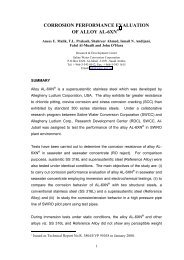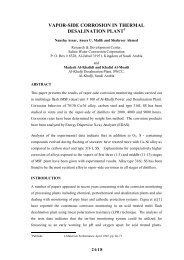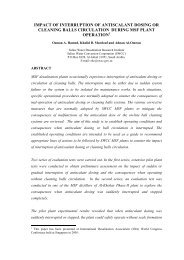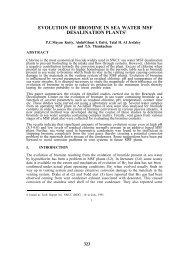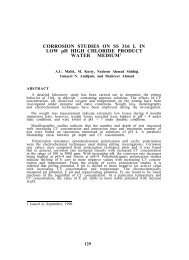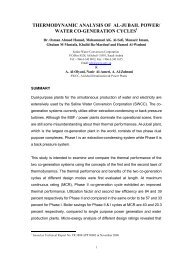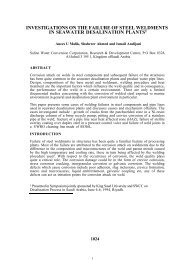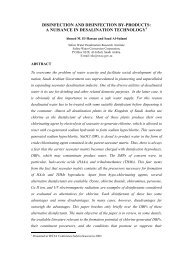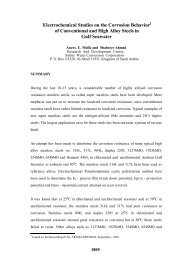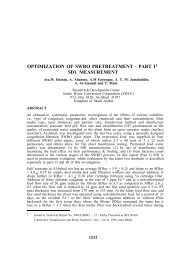studies on the role of sulfamic acid as a descalant in desalination ...
studies on the role of sulfamic acid as a descalant in desalination ...
studies on the role of sulfamic acid as a descalant in desalination ...
Create successful ePaper yourself
Turn your PDF publications into a flip-book with our unique Google optimized e-Paper software.
STUDIES ON THE ROLE OF SULFAMIC ACID AS<br />
A DESCALANT IN DESALINATION PLANTS 1<br />
Anees U Malik, I.N.Andijani, N.A.Siddiqi,<br />
Shahreer Ahmed and A.S. Al-Mobayaed*<br />
(*Chemistry Lab, Al-Jubail Desal<strong>in</strong>ati<strong>on</strong> Plant)<br />
ABSTRACT<br />
Sulfamic <strong>acid</strong> (HSO3NH2) amido sulfuric <strong>acid</strong>) h<strong>as</strong> l<strong>on</strong>g been used <strong>as</strong> an <strong>in</strong>dustrial<br />
clean<strong>in</strong>g agent due to its remarkable property <strong>of</strong> solubilis<strong>in</strong>g hard scales and most <strong>of</strong> <strong>the</strong><br />
deposits. Fur<strong>the</strong>rmore, it can be used <strong>on</strong> sta<strong>in</strong>less steels with no problem <strong>of</strong> pitt<strong>in</strong>g or<br />
chloride - <strong>in</strong>duced stress corrosi<strong>on</strong> crack<strong>in</strong>g (SCC). Sulfamic <strong>acid</strong> f<strong>in</strong>ds applicati<strong>on</strong> <strong>in</strong><br />
MSF desal<strong>in</strong>ati<strong>on</strong> plants for clean<strong>in</strong>g demisters, heat exchangers and cool<strong>in</strong>g water systerns.Optimizati<strong>on</strong><br />
<strong>in</strong> <strong>the</strong> <strong>sulfamic</strong> <strong>acid</strong> treatment is desirable <strong>in</strong> terms <strong>of</strong> plant efficiency<br />
and ec<strong>on</strong>omic c<strong>on</strong>siderati<strong>on</strong>s. However, <strong>in</strong>spite <strong>of</strong> its capability <strong>as</strong> a potential<br />
<strong>descalant</strong> and an excellent cleaner, <strong>the</strong> <strong>in</strong>dustrial chemical treatment is somewhat<br />
qualitative due to <strong>the</strong> lack <strong>of</strong> corrosi<strong>on</strong> and dissoluti<strong>on</strong> data regard<strong>in</strong>g <strong>sulfamic</strong> <strong>acid</strong>.<br />
The corrosi<strong>on</strong> and dissoluti<strong>on</strong> behavior <strong>of</strong> sta<strong>in</strong>less steels and copper-b<strong>as</strong>e alloys <strong>in</strong><br />
aqueous <strong>sulfamic</strong> <strong>acid</strong> and HCl soluti<strong>on</strong>s have been studied. Short and l<strong>on</strong>g terms<br />
immersi<strong>on</strong> tests al<strong>on</strong>g with electrochemical polarizari<strong>on</strong> resistance technique have been<br />
used to determ<strong>in</strong>e <strong>the</strong> descal<strong>in</strong>g and corrosi<strong>on</strong> rates. The effect <strong>of</strong> additi<strong>on</strong> <strong>of</strong> corrosi<strong>on</strong><br />
<strong>in</strong>hibitor to <strong>the</strong> <strong>acid</strong> <strong>on</strong> <strong>the</strong> corrosi<strong>on</strong> rates <strong>of</strong> <strong>the</strong> alloys h<strong>as</strong> also been studied. Some<br />
<str<strong>on</strong>g>studies</str<strong>on</strong>g> have been canied out under plant simulated c<strong>on</strong>diti<strong>on</strong>s when scaled/deposited<br />
demisters were treated with <strong>sulfamic</strong> <strong>acid</strong> and hydrochloric <strong>acid</strong>.The results <strong>of</strong> <strong>the</strong> <str<strong>on</strong>g>studies</str<strong>on</strong>g><br />
<strong>in</strong>dicate that an optimum c<strong>on</strong>centrati<strong>on</strong> <strong>of</strong> <strong>sulfamic</strong> <strong>acid</strong> or HCl for descal<strong>in</strong>g <strong>the</strong><br />
alloys can be detenn<strong>in</strong>ed depend<strong>in</strong>g up<strong>on</strong> <strong>the</strong> nature and extent <strong>of</strong> scal<strong>in</strong>g. The<br />
mechanism <strong>of</strong> corrosi<strong>on</strong> <strong>of</strong> materials <strong>in</strong> presence <strong>of</strong> <strong>sulfamic</strong> <strong>acid</strong> h<strong>as</strong> also been discussed.<br />
INTRODUCTION<br />
Saudi Arabia is <strong>the</strong> world’s largest desal<strong>in</strong>ated water producer from multi stage fl<strong>as</strong>h<br />
evaporati<strong>on</strong> (MSF) seawater desal<strong>in</strong>ati<strong>on</strong> plants. These plants use <strong>acid</strong> or additive<br />
1 Issued <strong>as</strong> Technical Report No. SWCC RDC)-32 <strong>in</strong> December, 1993.<br />
1001
treatment for scale c<strong>on</strong>trol. Scales are generally formed <strong>in</strong> <strong>the</strong> heat <strong>in</strong>put and recovery<br />
secti<strong>on</strong>s <strong>of</strong> MSF units because <strong>of</strong> high br<strong>in</strong>e c<strong>on</strong>centrati<strong>on</strong>, high top temperature,<br />
or high pH. The formati<strong>on</strong> <strong>of</strong> scales <strong>on</strong> <strong>the</strong> demisters is <strong>on</strong>e <strong>of</strong> <strong>the</strong> major problems<br />
encountered <strong>in</strong> <strong>the</strong> additive treated plants. No demisters foul<strong>in</strong>g w<strong>as</strong> observed <strong>in</strong> <strong>acid</strong><br />
treated unit operated for several years. Demister is arranged at <strong>the</strong> upper part <strong>of</strong> <strong>the</strong><br />
fl<strong>as</strong>h chamber to <strong>in</strong>tercept any such br<strong>in</strong>e droplets and to prevent <strong>the</strong>m from be<strong>in</strong>g<br />
carried out <strong>in</strong>to <strong>the</strong> distillate tray. Therefore, <strong>acid</strong> clean<strong>in</strong>g system is very essential to<br />
remove alkal<strong>in</strong>e deposits dur<strong>in</strong>g operati<strong>on</strong> with additive. Different SWCC’s desal<strong>in</strong>ati<strong>on</strong><br />
plants use different k<strong>in</strong>ds <strong>of</strong> <strong>acid</strong>s. The Al-Jubail desal<strong>in</strong>ati<strong>on</strong> plant uses additive<br />
treatment for scale c<strong>on</strong>trol, <strong>the</strong> scaled demisters are cleaned mechanically by dipp<strong>in</strong>g<br />
<strong>the</strong>m <strong>in</strong> a 5% <strong>sulfamic</strong> <strong>acid</strong> soluti<strong>on</strong> with additi<strong>on</strong> <strong>of</strong> a corrosi<strong>on</strong> <strong>in</strong>hibitor (IBIT).<br />
Equal amounts <strong>of</strong> HCl and H2S04 with corrosi<strong>on</strong> <strong>in</strong>hibitor (IBIT) are used <strong>in</strong> Al-<br />
Khobar desal<strong>in</strong>ati<strong>on</strong> plant. HCl with a different k<strong>in</strong>d <strong>of</strong> <strong>in</strong>hibitor, ARMOHIB 28<br />
h<strong>as</strong> been used <strong>in</strong> Jeddah desal<strong>in</strong>ati<strong>on</strong> plant while Khafji plant uses 5% HCl without<br />
additi<strong>on</strong> <strong>of</strong> any <strong>in</strong>hibitor. Sulfamic <strong>acid</strong> is also used <strong>in</strong> remov<strong>in</strong>g scales from open<br />
circuit cool<strong>in</strong>g water systems and heat exchanger tubes <strong>in</strong> desal<strong>in</strong>ati<strong>on</strong> plants.<br />
Sulfamic <strong>acid</strong> (HS03NH2 amido sulfuric <strong>acid</strong>) is <strong>the</strong> m<strong>on</strong>oamide <strong>of</strong> sulfuric <strong>acid</strong> and<br />
is formed <strong>in</strong> orthorhombic crystals (m.p. 205 o C). The pure crystals are n<strong>on</strong>-volatile,<br />
n<strong>on</strong>-hygroscopic and odorless. It is highly stable and it can be kept for years without<br />
any change <strong>in</strong> properties. Sulfamic <strong>acid</strong> behaves <strong>as</strong> a str<strong>on</strong>g <strong>acid</strong> <strong>in</strong> aqueous soluti<strong>on</strong><br />
but <strong>the</strong> corrosi<strong>on</strong> rates are significantly lower <strong>in</strong> comparis<strong>on</strong> to o<strong>the</strong>r <strong>acid</strong>s [l] (Table-l).<br />
The low corrosi<strong>on</strong> rates can be reduced fur<strong>the</strong>r by <strong>the</strong> additi<strong>on</strong> <strong>of</strong> corrosi<strong>on</strong><br />
<strong>in</strong>hibitors [2]. The aqueous soluti<strong>on</strong>s <strong>of</strong> <strong>sulfamic</strong> <strong>acid</strong> do not emit corrosive fumes<br />
and solubilize hard water scales and form soluble compounds with most <strong>of</strong> <strong>the</strong> <strong>in</strong>dustrial<br />
deposits [3]. It can be used for clean<strong>in</strong>g sta<strong>in</strong>less steels with no problem <strong>of</strong> chloride<br />
<strong>in</strong>duced stress corrosi<strong>on</strong> crack<strong>in</strong>g. Due to <strong>the</strong>se formidable properties, <strong>acid</strong><br />
cleaners b<strong>as</strong>ed <strong>on</strong> <strong>sulfamic</strong> <strong>acid</strong> are extensively used <strong>in</strong> a large variety <strong>of</strong> household<br />
and <strong>in</strong>dustrial applicati<strong>on</strong>s. Recently, suggesti<strong>on</strong>s have been made to replace <strong>sulfamic</strong><br />
<strong>acid</strong> by HCl for removal <strong>of</strong> <strong>the</strong> scales from demisters due to slower acti<strong>on</strong> <strong>of</strong><br />
<strong>the</strong> former and also much higher costs <strong>in</strong>volved <strong>in</strong> us<strong>in</strong>g <strong>sulfamic</strong> <strong>acid</strong> <strong>in</strong> comparis<strong>on</strong><br />
to HCl. One obvious problem <strong>in</strong> us<strong>in</strong>g HCl is <strong>the</strong> possibility <strong>of</strong> pitt<strong>in</strong>g and/or SCC<br />
<strong>on</strong> sta<strong>in</strong>less steels through Cl - <strong>in</strong>duced attack. As <strong>the</strong> corrosi<strong>on</strong> data for sta<strong>in</strong>less<br />
steels and o<strong>the</strong>r c<strong>on</strong>structi<strong>on</strong> materials <strong>in</strong> presence <strong>of</strong> <strong>sulfamic</strong> <strong>acid</strong> are lack<strong>in</strong>g, a<br />
systematic study h<strong>as</strong> been carried out to study <strong>the</strong> corrosi<strong>on</strong> behavior <strong>of</strong> <strong>sulfamic</strong> <strong>acid</strong><br />
to qualitatively evaluate <strong>the</strong> capability <strong>of</strong> <strong>sulfamic</strong> <strong>acid</strong> <strong>as</strong> a clean<strong>in</strong>g agent/descalent.<br />
This report <strong>in</strong>corporates <strong>the</strong> results <strong>of</strong> a systematic study carried out to <strong>in</strong>vestigate<br />
<strong>the</strong> corrosi<strong>on</strong> behavior <strong>of</strong> carb<strong>on</strong> steel, SS 316L, 70-30 and 90-10 Cupro-nickel <strong>in</strong><br />
presence <strong>of</strong> <strong>sulfamic</strong> <strong>acid</strong> and hydrochloric <strong>acid</strong> with or without <strong>the</strong> additi<strong>on</strong> <strong>of</strong> an<br />
1002
<strong>in</strong>hibitor. The <strong>role</strong> <strong>of</strong> <strong>acid</strong> c<strong>on</strong>centrati<strong>on</strong> <strong>on</strong> <strong>the</strong> corrosi<strong>on</strong> or descal<strong>in</strong>g rates h<strong>as</strong> specifically<br />
been <strong>in</strong>vestigated with special reference to <strong>the</strong> performance <strong>of</strong> <strong>sulfamic</strong> <strong>acid</strong><br />
<strong>in</strong> a desal<strong>in</strong>ati<strong>on</strong> plant. The results <strong>of</strong> an <strong>in</strong>vestigati<strong>on</strong> c<strong>on</strong>cern<strong>in</strong>g with <strong>the</strong> scaled<br />
demisters have also been <strong>in</strong>cluded.<br />
EXPERIMENTS<br />
Materials<br />
Carb<strong>on</strong> steel, 316L sta<strong>in</strong>less steel and 70-30, 90-10 cupr<strong>on</strong>ickel were obta<strong>in</strong>ed commercially<br />
<strong>in</strong> sheet and/or rod forms. The flat, circular flat or cyl<strong>in</strong>drical specimens<br />
were used dur<strong>in</strong>g <strong>the</strong> experiments without any fur<strong>the</strong>r heat treatment. The chemical<br />
compositi<strong>on</strong> <strong>of</strong> <strong>the</strong> alloys is given <strong>in</strong> Table-2.<br />
Sulfamic <strong>acid</strong> <strong>in</strong> powder form and corrosi<strong>on</strong> <strong>in</strong>hibitor (IBIT) <strong>in</strong> liquid form were<br />
obta<strong>in</strong>ed from Al-Jubail desal<strong>in</strong>ati<strong>on</strong> plant. The <strong>in</strong>hibitor (ARMOHIB 28) used with<br />
hydrochloric <strong>acid</strong> w<strong>as</strong> obta<strong>in</strong>ed from Jeddah desal<strong>in</strong>ati<strong>on</strong> plant.<br />
Sulfamic <strong>acid</strong> and hydrochloric <strong>acid</strong> soluti<strong>on</strong>s <strong>of</strong> vary<strong>in</strong>g c<strong>on</strong>centrati<strong>on</strong> (range 2% to<br />
10%) were prepared with and without additi<strong>on</strong> <strong>of</strong> a corrosi<strong>on</strong> <strong>in</strong>hibitor. 450 ml <strong>of</strong><br />
10% <strong>acid</strong> soluti<strong>on</strong> with 10% <strong>in</strong>hibitor w<strong>as</strong> prepared by dissolv<strong>in</strong>g 4.5 grams <strong>of</strong> <strong>acid</strong><br />
powder plus 4.5 ml <strong>of</strong> <strong>in</strong>hibitor soluti<strong>on</strong> <strong>in</strong> distilled water. Similarly, 450 ml <strong>of</strong> 5%<br />
<strong>acid</strong> soluti<strong>on</strong> with 5% <strong>in</strong>hibitor w<strong>as</strong> prepared by dissolv<strong>in</strong>g 22.5 grams <strong>of</strong> <strong>acid</strong> powder<br />
plus 1.125 ml <strong>of</strong> <strong>in</strong>hibitor soluti<strong>on</strong> <strong>in</strong> distilled water.<br />
Techniques & Procedure<br />
Electrochemical Polarizati<strong>on</strong> Studies:<br />
Electrochemical polarizati<strong>on</strong> resistance experiments were carried out us<strong>in</strong>g an<br />
EG&G model 342-2 s<strong>of</strong>t Corr me<strong>as</strong>urement system. The system is c<strong>on</strong>sisted <strong>of</strong><br />
Model 273 Potentiostat/Galvanostat, Model 342 s<strong>of</strong>t Corr s<strong>of</strong>tware and Model 30<br />
IBM PS/2. All <strong>the</strong> experiments were carried out us<strong>in</strong>g a corrosi<strong>on</strong> cell with saturated<br />
calomel <strong>as</strong> reference and graphite <strong>as</strong> counter electrodes. Circular, flat or cyl<strong>in</strong>drical<br />
test specimens were used. The exposed area <strong>of</strong> <strong>the</strong> test specimens which w<strong>as</strong> screwed<br />
<strong>in</strong> <strong>the</strong> sample holder w<strong>as</strong> 1 cm 2 .<br />
The polarizati<strong>on</strong> resistance me<strong>as</strong>urements were c<strong>on</strong>ducted at a scane rate <strong>of</strong> 0.1<br />
mV/s with start<strong>in</strong>g and f<strong>in</strong>al potentials corresp<strong>on</strong>d<strong>in</strong>g to -20 mV to + 20 mV vs OCP,<br />
1003
espectively. Before start<strong>in</strong>g <strong>the</strong> experiments, <strong>the</strong> specimens (W.E.) were left <strong>in</strong> <strong>the</strong><br />
<strong>acid</strong> soluti<strong>on</strong> for about 1 hour to atta<strong>in</strong> a steady state which w<strong>as</strong> shown by a c<strong>on</strong>stant<br />
potential.<br />
Immersi<strong>on</strong> Tests<br />
Immersi<strong>on</strong> tests were carried <strong>on</strong> 316L sta<strong>in</strong>less steel, carb<strong>on</strong> steel, 70-30 and 90-10<br />
cupr<strong>on</strong>ickel alloys <strong>in</strong> 5% <strong>sulfamic</strong> <strong>acid</strong> soluti<strong>on</strong> and 3% HCl soluti<strong>on</strong> with and without<br />
additi<strong>on</strong> <strong>of</strong> different c<strong>on</strong>centrati<strong>on</strong>s <strong>of</strong> corrosi<strong>on</strong> <strong>in</strong>hibitor at room temperature<br />
under dynamic c<strong>on</strong>diti<strong>on</strong>s. Coup<strong>on</strong>s <strong>of</strong> about 60x40x2 mm dimensi<strong>on</strong>s were cut from<br />
<strong>the</strong> sheet and abraded with 180 grit SiC paper. The abraded coup<strong>on</strong>s were cleaned<br />
ultr<strong>as</strong><strong>on</strong>ically and dried. The dried coup<strong>on</strong>s were weighed.<br />
Two coup<strong>on</strong>s from each alloy were immersed <strong>in</strong> test soluti<strong>on</strong> under dynamic c<strong>on</strong>diti<strong>on</strong>s.<br />
Four test soluti<strong>on</strong> c<strong>on</strong>diti<strong>on</strong>s were used: 5% <strong>sulfamic</strong> <strong>acid</strong> 3% HCl with 0%,<br />
2%, 5% and 10% <strong>in</strong>hibitor.<br />
Descal<strong>in</strong>g Experiments<br />
A used mist-separator (demister) c<strong>on</strong>ta<strong>in</strong><strong>in</strong>g scale layers <strong>on</strong> <strong>the</strong> knitted SS 316L wire<br />
mesh pad’w<strong>as</strong> obta<strong>in</strong>ed from <strong>the</strong> Al-Jubail desal<strong>in</strong>ati<strong>on</strong> plant (Fig.1) for study<strong>in</strong>g <strong>the</strong><br />
descal<strong>in</strong>g performance <strong>of</strong> <strong>sulfamic</strong> <strong>acid</strong> and hydrochloric <strong>acid</strong> and <strong>the</strong> effect <strong>of</strong> corrosi<strong>on</strong><br />
<strong>in</strong>hibitor <strong>in</strong> dissoluti<strong>on</strong> process. Samples from demister were immersed <strong>in</strong> different<br />
c<strong>on</strong>centrati<strong>on</strong>s <strong>of</strong> <strong>sulfamic</strong> <strong>acid</strong> and hydrochloric <strong>acid</strong> with and without<br />
<strong>in</strong>hibitor under static and dynamic c<strong>on</strong>diti<strong>on</strong>s. All <strong>the</strong> experiments were carried out<br />
at room temperature. The deposits/scales <strong>on</strong> wire mesh were analyzed chemically<br />
and it w<strong>as</strong> found that deposits are <strong>the</strong> carb<strong>on</strong>ates and hydroxides <strong>of</strong> magnesium,<br />
(30%) and calcium (2%).<br />
RESULTS AND DISCUSSION<br />
Polarizati<strong>on</strong> Resistance Tests<br />
Table 3 lists <strong>the</strong> corrosi<strong>on</strong> rate values <strong>of</strong> alloys <strong>in</strong> three <strong>sulfamic</strong> <strong>acid</strong> c<strong>on</strong>centrati<strong>on</strong>s,<br />
e.g., 2%, 5% and 10% at room temperature under static c<strong>on</strong>diti<strong>on</strong>, <strong>the</strong> values are<br />
computed from <strong>the</strong> l<strong>in</strong>ear polarizati<strong>on</strong> resistance plots. These values are b<strong>as</strong>ed <strong>on</strong><br />
<strong>the</strong> cathodic and anodic tafel values which were obta<strong>in</strong>ed from previously carried out<br />
tafel plot runs. The results show that without <strong>in</strong>hibitor, <strong>the</strong> corrosi<strong>on</strong> rates <strong>of</strong> carb<strong>on</strong><br />
steel are highest (< 60 MPY) and that <strong>of</strong> SS 316L are lowest (> 0.5 MPY), cupr<strong>on</strong>ickel<br />
alloys occupy<strong>in</strong>g middle positi<strong>on</strong> (2-6 MPY). It appears that <strong>the</strong> effect <strong>of</strong> vary-<br />
1004
<strong>in</strong>g <strong>sulfamic</strong> <strong>acid</strong> c<strong>on</strong>centrati<strong>on</strong> (2,5 and 10%) <strong>on</strong> <strong>the</strong> corrosi<strong>on</strong> rates is not very<br />
significant <strong>as</strong> <strong>in</strong>dicated by <strong>the</strong> similar corrosi<strong>on</strong> rates <strong>of</strong> <strong>the</strong> alloys. However, <strong>the</strong><br />
additi<strong>on</strong> <strong>of</strong> <strong>in</strong>hibitor to <strong>sulfamic</strong> <strong>acid</strong> lowers down <strong>the</strong> corrosi<strong>on</strong> rates c<strong>on</strong>siderably<br />
especially that <strong>of</strong> carb<strong>on</strong> steel and cupr<strong>on</strong>ickel alloys. Moreover, <strong>the</strong> effect <strong>of</strong> variati<strong>on</strong><br />
<strong>in</strong> <strong>in</strong>hibitor c<strong>on</strong>centrati<strong>on</strong> <strong>on</strong> corrosi<strong>on</strong> rates is quite significant. For example,<br />
with 10% <strong>acid</strong> and 5% <strong>in</strong>hibitor, <strong>the</strong> corrosi<strong>on</strong> rates are : carb<strong>on</strong> steel: < 9 MPY, SS<br />
316L: < 0.4 MPY and cupr<strong>on</strong>ickel: < 0.8, and additi<strong>on</strong> <strong>of</strong> 10% <strong>of</strong> <strong>in</strong>hibitor reduces <strong>the</strong><br />
corrosi<strong>on</strong> rate still fur<strong>the</strong>r e.g., carb<strong>on</strong> steel: < 4.7 MPY, SS 316L : < 0.18 MPY and<br />
cupr<strong>on</strong>ickel : < 0.07 MPY. Table 4 lists <strong>the</strong> corrosi<strong>on</strong> rates <strong>of</strong> alloys at 5% <strong>sulfamic</strong><br />
<strong>acid</strong> without <strong>in</strong>hibitor and with additi<strong>on</strong>s <strong>of</strong> 2%, 5% and 10% <strong>in</strong>hibitor under<br />
dynamic c<strong>on</strong>diti<strong>on</strong>s. The results <strong>in</strong>dicate that <strong>the</strong> corrosi<strong>on</strong> rates <strong>of</strong> alloys under<br />
dynamic c<strong>on</strong>diti<strong>on</strong>s are generally higher than that under static c<strong>on</strong>diti<strong>on</strong>s. Figures 2<br />
to 4 show trends <strong>in</strong> <strong>the</strong> variati<strong>on</strong> <strong>of</strong> corrosi<strong>on</strong> rate <strong>of</strong> alloys with <strong>in</strong>cre<strong>as</strong><strong>in</strong>g <strong>in</strong>hibitor<br />
c<strong>on</strong>centrati<strong>on</strong> under static and dynamic c<strong>on</strong>diti<strong>on</strong>s.<br />
Tables 5&6 lists <strong>the</strong> corrosi<strong>on</strong> rates <strong>of</strong> three alloys by polarizati<strong>on</strong> resistance technique<br />
<strong>in</strong> HCl with and without additi<strong>on</strong> <strong>of</strong> <strong>in</strong>hibitor (ARMOHIB 28) under static and<br />
dynamic c<strong>on</strong>diti<strong>on</strong>s. A comparis<strong>on</strong> <strong>of</strong> corrosi<strong>on</strong> rate values <strong>of</strong> three alloys <strong>in</strong> <strong>sulfamic</strong><br />
<strong>acid</strong> and HCl <strong>in</strong>dicates that <strong>the</strong> latter h<strong>as</strong> rates l-2 order <strong>of</strong> magnitude higher than<br />
<strong>the</strong> former.<br />
An analysis <strong>of</strong> <strong>the</strong> corrosi<strong>on</strong> rates <strong>of</strong> alloys obta<strong>in</strong>ed from polarizati<strong>on</strong> resistance<br />
techniques <strong>in</strong>dicates that under static or dynamic c<strong>on</strong>diti<strong>on</strong>s, <strong>the</strong>re is a steep fall <strong>in</strong><br />
corrosi<strong>on</strong> rates <strong>on</strong> <strong>in</strong>cre<strong>as</strong><strong>in</strong>g <strong>the</strong> <strong>in</strong>hibitor c<strong>on</strong>centrati<strong>on</strong> up to 5% followed by a slow<br />
decre<strong>as</strong>e or virtually no lower<strong>in</strong>g <strong>in</strong> corrosi<strong>on</strong> rates <strong>in</strong> <strong>the</strong> <strong>in</strong>hibitor c<strong>on</strong>centrati<strong>on</strong><br />
range <strong>of</strong> 5-10%.<br />
Immersi<strong>on</strong> Tests<br />
The results <strong>of</strong> immersi<strong>on</strong> test <strong>of</strong> alloys <strong>in</strong> 5% <strong>sulfamic</strong> <strong>acid</strong> soluti<strong>on</strong> <strong>in</strong> presence <strong>of</strong><br />
<strong>in</strong>hibitor (c<strong>on</strong>centrati<strong>on</strong> : 0, 2, 5 and 10%) at room temperature and under dynamic<br />
c<strong>on</strong>diti<strong>on</strong> are summarized <strong>in</strong> Table 7. For SS 316L no perceptible weight change w<strong>as</strong><br />
recorded for <strong>the</strong> coup<strong>on</strong>s immersed under all test soluti<strong>on</strong> c<strong>on</strong>diti<strong>on</strong>s for a durati<strong>on</strong><br />
<strong>of</strong> 70 days. For carb<strong>on</strong> steel, highest corrosi<strong>on</strong> rate w<strong>as</strong> 139 MPY without <strong>in</strong>hibitor<br />
followed by 81 MPY <strong>on</strong> additi<strong>on</strong> <strong>of</strong> 2% <strong>in</strong>hibitor, <strong>the</strong> corrosi<strong>on</strong> rates lowered down<br />
to about 47 at 5% and 10% <strong>in</strong>hibitor c<strong>on</strong>centrati<strong>on</strong>s, respectively.<br />
Cupr<strong>on</strong>ickel alloys have much lower corrosi<strong>on</strong> rates than carb<strong>on</strong> steels, <strong>the</strong> effect <strong>of</strong><br />
<strong>in</strong>hibitor additi<strong>on</strong> is very pr<strong>on</strong>ounced at 5% and higher c<strong>on</strong>centrati<strong>on</strong>s <strong>of</strong> <strong>in</strong>hibitor<br />
when corrosi<strong>on</strong> rates are lowered down from 0.06 to about 0 MPY. Fig. 5 shows<br />
1005
trends <strong>in</strong> <strong>the</strong> variati<strong>on</strong> <strong>of</strong> corrosi<strong>on</strong> rates <strong>of</strong> alloys with <strong>in</strong>cre<strong>as</strong><strong>in</strong>g <strong>in</strong>hibitor c<strong>on</strong>centrati<strong>on</strong><br />
under dynamic c<strong>on</strong>diti<strong>on</strong>s. Effect <strong>of</strong> additi<strong>on</strong> <strong>of</strong> <strong>in</strong>hibitor is clearly seen <strong>on</strong> <strong>the</strong><br />
coup<strong>on</strong>s. Fig. 6 shows uniform dealloy<strong>in</strong>g <strong>on</strong> <strong>the</strong> coup<strong>on</strong> when <strong>the</strong>re w<strong>as</strong> no additi<strong>on</strong><br />
<strong>of</strong> <strong>in</strong>hibitor. While Fig. 7 shows selective dealloy<strong>in</strong>g when <strong>the</strong> amount <strong>of</strong> <strong>in</strong>hibitor<br />
w<strong>as</strong> 2%. Figs 8, 9, 10 show typical microstructures represent<strong>in</strong>g dealloy<strong>in</strong>g at different<br />
<strong>in</strong>hibitor c<strong>on</strong>centrati<strong>on</strong>s, Corrosi<strong>on</strong> rates <strong>of</strong> 70 Cu-30 Ni alloys are significantly<br />
lower than 90 Cu-10 Ni alloys.<br />
Table 8 lists <strong>the</strong> result <strong>of</strong> immersi<strong>on</strong> tests <strong>of</strong> alloys <strong>in</strong> 3% hydrochloric <strong>acid</strong> with 0%,<br />
3%, 5% and 10% <strong>in</strong>hibitor under dynamic c<strong>on</strong>diti<strong>on</strong>s at room temperature. All <strong>the</strong><br />
three alloys show very high corrosi<strong>on</strong> rates when <strong>the</strong>re is no additi<strong>on</strong> <strong>of</strong> <strong>in</strong>hibitor viz<br />
SS 316L (75 MPY), 70 Cu-30Ni (630 MPY) and 90 Cu-10 Ni (605 MPY). Corrosi<strong>on</strong><br />
rates lower down dr<strong>as</strong>tically after <strong>the</strong> additi<strong>on</strong> <strong>of</strong> <strong>in</strong>hibitor except <strong>in</strong> <strong>the</strong> c<strong>as</strong>e <strong>of</strong> SS<br />
316L where <strong>the</strong> corrosi<strong>on</strong> rate is 48 MPY with 3% <strong>in</strong>hibitor. Fig.11 shows trends <strong>in</strong><br />
<strong>the</strong> variati<strong>on</strong> <strong>of</strong> corrosi<strong>on</strong> rates <strong>of</strong> <strong>the</strong> three alloys with <strong>in</strong>cre<strong>as</strong><strong>in</strong>g <strong>in</strong>hibitor c<strong>on</strong>centrati<strong>on</strong><br />
under dynamic c<strong>on</strong>diti<strong>on</strong>. Compar<strong>in</strong>g <strong>the</strong> corrosi<strong>on</strong> rate values determ<strong>in</strong>ed<br />
from electrochemical polarizati<strong>on</strong> and immersi<strong>on</strong> tests, two important po<strong>in</strong>ts are<br />
emerged: (i) <strong>the</strong> trend <strong>in</strong> lower<strong>in</strong>g <strong>of</strong> corrosi<strong>on</strong> rate <strong>on</strong> <strong>in</strong>cre<strong>as</strong><strong>in</strong>g <strong>in</strong>hibitor’s c<strong>on</strong>centrati<strong>on</strong><br />
is similar <strong>in</strong> both <strong>the</strong> methods i.e. <strong>the</strong> m<strong>in</strong>imum corrosi<strong>on</strong> rates are at about<br />
510% <strong>in</strong>hibitor c<strong>on</strong>centrati<strong>on</strong> (ii) under dynamic c<strong>on</strong>diti<strong>on</strong>, <strong>the</strong> corrosi<strong>on</strong> rates for<br />
carb<strong>on</strong> steel and cupr<strong>on</strong>ickels determ<strong>in</strong>ed from immersi<strong>on</strong> tests are higher than that<br />
determ<strong>in</strong>ed by polarizati<strong>on</strong> resistance technique. The higher corrosi<strong>on</strong> rates dur<strong>in</strong>g<br />
immersi<strong>on</strong> tests could be attributed to <strong>the</strong> process <strong>of</strong> break<strong>in</strong>g and reformati<strong>on</strong> <strong>of</strong> <strong>the</strong><br />
protective oxide film till a thick oxide deposit is formed <strong>on</strong> <strong>the</strong> metal which does not<br />
allow fur<strong>the</strong>r corrosi<strong>on</strong>. The rates determ<strong>in</strong>ed by electrochemical polarizati<strong>on</strong><br />
resistance technique are lower because <strong>of</strong> <strong>the</strong> range <strong>of</strong> potential traverse is very small<br />
with<strong>in</strong> +/- 20mV from 0.C.P and obviously, <strong>the</strong> potentials applied with<strong>in</strong> such a narrow<br />
range would not likely to <strong>in</strong>duce any change <strong>in</strong> <strong>the</strong> surface characteristics <strong>of</strong> <strong>the</strong><br />
alloy.<br />
Descal<strong>in</strong>g Tests <strong>on</strong> Fouled Demister<br />
Table 9 shows amount <strong>of</strong> scales removed from fouled demister (316L) samples after<br />
dipp<strong>in</strong>g <strong>in</strong> <strong>sulfamic</strong> <strong>acid</strong> soluti<strong>on</strong>s for 19 hours under static c<strong>on</strong>diti<strong>on</strong>s. Aqueous <strong>sulfamic</strong><br />
<strong>acid</strong> soluti<strong>on</strong>s <strong>of</strong> c<strong>on</strong>centrati<strong>on</strong> 3%, 5% and 10% with additi<strong>on</strong> <strong>of</strong> 0 %, 2%, 5%<br />
or 10% <strong>in</strong>hibitor were used dur<strong>in</strong>g descal<strong>in</strong>g tests. The results <strong>in</strong>dicate that under<br />
static c<strong>on</strong>diti<strong>on</strong>s, <strong>sulfamic</strong> <strong>acid</strong> <strong>on</strong>ly partially removes scales from <strong>the</strong> demister and<br />
<strong>the</strong> additi<strong>on</strong> <strong>of</strong> <strong>in</strong>hibitor h<strong>as</strong> <strong>on</strong>ly marg<strong>in</strong>al effect <strong>on</strong> descal<strong>in</strong>g. The data fur<strong>the</strong>r<br />
shows that <strong>the</strong> descal<strong>in</strong>g is resulted <strong>in</strong> presence <strong>of</strong> 3%, 5% and 10% <strong>sulfamic</strong> <strong>acid</strong><br />
soluti<strong>on</strong> under dynamic c<strong>on</strong>diti<strong>on</strong>s. The rate <strong>of</strong> descal<strong>in</strong>g is very f<strong>as</strong>t and maximum<br />
1006
amount <strong>of</strong> scales were removed from samples with<strong>in</strong> 1 hour. The results <strong>in</strong>dicate that<br />
<strong>the</strong> additi<strong>on</strong> <strong>of</strong> <strong>in</strong>hibitor did not effect <strong>the</strong> descal<strong>in</strong>g process. As expected <strong>the</strong> descal<strong>in</strong>g<br />
efficiency <strong>in</strong> dynamic c<strong>on</strong>diti<strong>on</strong> is much better than under static c<strong>on</strong>diti<strong>on</strong>.<br />
Descal<strong>in</strong>g test by hydrochloric <strong>acid</strong> w<strong>as</strong> carried out at 3%, 5% and 10% c<strong>on</strong>centrati<strong>on</strong>s<br />
under dynamic c<strong>on</strong>diti<strong>on</strong>s Table 9. Results show that with<strong>in</strong> hours, <strong>the</strong> scales<br />
are totally removed. Compar<strong>in</strong>g <strong>the</strong>se results with that <strong>of</strong> <strong>sulfamic</strong> <strong>acid</strong> it is obvious<br />
that hydrochloric <strong>acid</strong> is a much more powerful <strong>descalant</strong> than <strong>sulfamic</strong> <strong>acid</strong>. The<br />
plots <strong>of</strong> <strong>acid</strong> (<strong>sulfamic</strong> <strong>acid</strong> or HCl) versus amount <strong>of</strong> scales removed Figure 12 can<br />
provide a method to determ<strong>in</strong>e <strong>the</strong> quantity <strong>of</strong> <strong>acid</strong> required to remove <strong>the</strong> scale<br />
completely from <strong>the</strong> demister or vice-versa under dynamic c<strong>on</strong>diti<strong>on</strong>s.<br />
GENERAL CONCLUSIONS<br />
1. Under static c<strong>on</strong>diti<strong>on</strong>s, <strong>the</strong> effect <strong>of</strong> variati<strong>on</strong> <strong>in</strong> <strong>sulfamic</strong> <strong>acid</strong> c<strong>on</strong>centrati<strong>on</strong> <strong>on</strong><br />
corrosi<strong>on</strong> rates <strong>of</strong> steel, cupr<strong>on</strong>ickel and AISI 316L is not significant but additi<strong>on</strong><br />
<strong>of</strong> <strong>in</strong>hibitor to <strong>sulfamic</strong> <strong>acid</strong> br<strong>in</strong>gs down <strong>the</strong> corrosi<strong>on</strong> rate by l-2 order <strong>of</strong><br />
magnitude.<br />
2. The corrosi<strong>on</strong> rates under dynamic immersi<strong>on</strong> c<strong>on</strong>diti<strong>on</strong>s for <strong>the</strong> alloys are<br />
higher than that determ<strong>in</strong>ed by polarizati<strong>on</strong> technique. The lower rates by electrochemical<br />
polarizati<strong>on</strong> technique are attributed to <strong>the</strong> narrow range <strong>of</strong> applied<br />
potential which would not <strong>in</strong>duce any significant change <strong>in</strong> <strong>the</strong> surface<br />
characteristics <strong>of</strong> <strong>the</strong> alloy.<br />
3. Under static c<strong>on</strong>diti<strong>on</strong>s, <strong>sulfamic</strong> <strong>acid</strong> <strong>on</strong>ly partially removes scales from <strong>the</strong><br />
demister even after submerg<strong>in</strong>g it for a period <strong>of</strong> more than 18 hrs, however,<br />
under dynamic c<strong>on</strong>diti<strong>on</strong>s, 3% or 5% <strong>sulfamic</strong> <strong>acid</strong> soluti<strong>on</strong>s completely remove<br />
<strong>the</strong> scales with<strong>in</strong> 1 hr. In both <strong>the</strong> c<strong>on</strong>diti<strong>on</strong>, additi<strong>on</strong> <strong>of</strong> <strong>in</strong>hibitor to <strong>the</strong> <strong>acid</strong><br />
h<strong>as</strong> <strong>on</strong>ly nom<strong>in</strong>al effect <strong>on</strong> descal<strong>in</strong>g.<br />
4. Besides higher corrosi<strong>on</strong> rates, hydrochloric <strong>acid</strong> exhibits much higher descal<strong>in</strong>g<br />
characteristics than <strong>sulfamic</strong> <strong>acid</strong>.<br />
5. Astandard plot between <strong>acid</strong> (Sulfamic <strong>acid</strong> or HCl) versus amount <strong>of</strong> scale<br />
removed can provide a method to determ<strong>in</strong>e <strong>the</strong> quantity <strong>of</strong> <strong>acid</strong> required to<br />
remove <strong>the</strong> scale from <strong>the</strong> demister or vice-versa under dynamic c<strong>on</strong>diti<strong>on</strong>s.<br />
1007
CONCLUDING REMARKS<br />
The results <strong>of</strong> <strong>the</strong> <str<strong>on</strong>g>studies</str<strong>on</strong>g> carried out <strong>on</strong> descal<strong>in</strong>g behavior <strong>of</strong> <strong>sulfamic</strong> <strong>acid</strong> <strong>in</strong>dicate<br />
that for descal<strong>in</strong>g <strong>of</strong> demisters (material: AISI 316L) <strong>in</strong> desal<strong>in</strong>ati<strong>on</strong> plants, <strong>sulfamic</strong><br />
<strong>acid</strong> is an efficient clean<strong>in</strong>g agent. S<strong>in</strong>ce additi<strong>on</strong> <strong>of</strong> an <strong>in</strong>hibitor does not have a<br />
significant effect <strong>on</strong> corrosi<strong>on</strong> rates. Therefore, additi<strong>on</strong> <strong>of</strong> <strong>in</strong>hibitor to <strong>sulfamic</strong> <strong>acid</strong><br />
is not required for clean<strong>in</strong>g purposes. In Cupro-nickel (70-30 or 90/10) heat<br />
exchangers <strong>in</strong> MSF plants, <strong>sulfamic</strong> <strong>acid</strong> is a good descal<strong>in</strong>g agent provided sufficient<br />
amount <strong>of</strong> corrosi<strong>on</strong> <strong>in</strong>hibitor is present. HCl <strong>in</strong> presence <strong>of</strong> <strong>in</strong>hibitor is a more efficient<br />
and cost effective descal<strong>in</strong>g agent but due to its high corrosi<strong>on</strong> rate and its tendency<br />
to <strong>in</strong>duce stress corrosi<strong>on</strong> crack<strong>in</strong>g <strong>the</strong> l<strong>on</strong>g term effects <strong>of</strong> its applicati<strong>on</strong> are<br />
to be m<strong>on</strong>itored.<br />
REFERENCES<br />
1. Encyclopedia <strong>of</strong> chemical technology, Vol. 21. Sulfamic Acid, pp 951-57, Wiley<br />
Interscience Publicati<strong>on</strong> (1983).<br />
2. Process Industries, NACE Publicati<strong>on</strong> (1986), pp 267-268.<br />
3. Metal Hand Book, Vol. 13, Corrosi<strong>on</strong>, Specific Industries and Envir<strong>on</strong>ments,<br />
American Society <strong>of</strong> Metals, 1987, pp 1140-1141.<br />
1008
1009
1010
1011
1012
1013
Figure l(a).<br />
Photograph <strong>of</strong> a used mist-separator (demister) show<strong>in</strong>g scale layers<br />
<strong>on</strong> <strong>the</strong> knitted SS 316L wire mesh.<br />
130<br />
1014
Figure 1(b). Close up view <strong>of</strong> <strong>the</strong> scaled wires <strong>of</strong> SS 316L.<br />
131<br />
1015
1016
1017
Figure 6. Photograph <strong>of</strong> 70/30 Cu/Ni coup<strong>on</strong> after expos<strong>in</strong>g to 5% <strong>sulfamic</strong> <strong>acid</strong><br />
without <strong>in</strong>hibitor show<strong>in</strong>g uniform dealloy<strong>in</strong>g.<br />
134<br />
1018
--_-_ -.-.<br />
_-<br />
Figure 7. Photograph <strong>of</strong> 70/30 Cu/Ni coup<strong>on</strong> after expos<strong>in</strong>g to 5% <strong>sulfamic</strong> <strong>acid</strong><br />
with 2% <strong>in</strong>hibitor show<strong>in</strong>g patches <strong>of</strong> dealloy<strong>in</strong>g.<br />
135<br />
1019
Figure 8. Microstructure <strong>of</strong> 70/30 after expos<strong>in</strong>g to 5% <strong>sulfamic</strong> <strong>acid</strong> with 2%<br />
<strong>in</strong>hibitor show<strong>in</strong>g unaffected z<strong>on</strong>e. 200 x.<br />
136<br />
1020
Figure 9.<br />
Same <strong>as</strong> above but <strong>on</strong> <strong>the</strong> dealloyed z<strong>on</strong>e<br />
137<br />
1021
Figure 10. Microstructure <strong>of</strong> 70/30 after expos<strong>in</strong>g to 5% <strong>sulfamic</strong> <strong>acid</strong> without<br />
<strong>the</strong> additi<strong>on</strong> <strong>of</strong> <strong>in</strong>hibitor, show<strong>in</strong>g uniform dealloys<strong>in</strong>g. 200 X.<br />
138<br />
1022
1023



